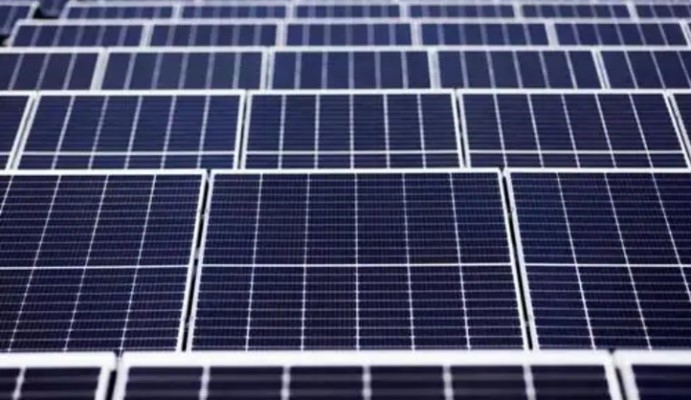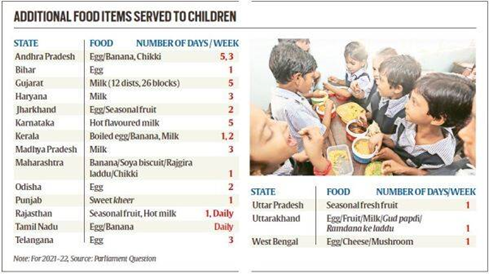Friday, 15th April 2022
Reservation in Promotion
In News
The Central government is set to start the process of collecting quantifiable data on representation of social groups at various government posts to finalise on the requirement of reservation in promotion.
About the News
- The Department of Personnel and Training (DoPT) has asked all departments of central government to collect the data on inadequacy of representation of Scheduled Castes and Scheduled Tribes before implementing the policy of reservation in promotion in government offices.
- The move comes as a major vacancy has risen in the Central Secretariat Service (CSS), as many officials have not been promoted since the last six years.
- The move appears to be aimed at ameliorating the SCs and STs communities, that constitute 15% and 7.5% reservation in government jobs, respectively.
- There has been years-long delay in clearing promotions for officers belonging to these groups.
The current collection of data is being done on the basis of a January 28 Supreme Court judgement.

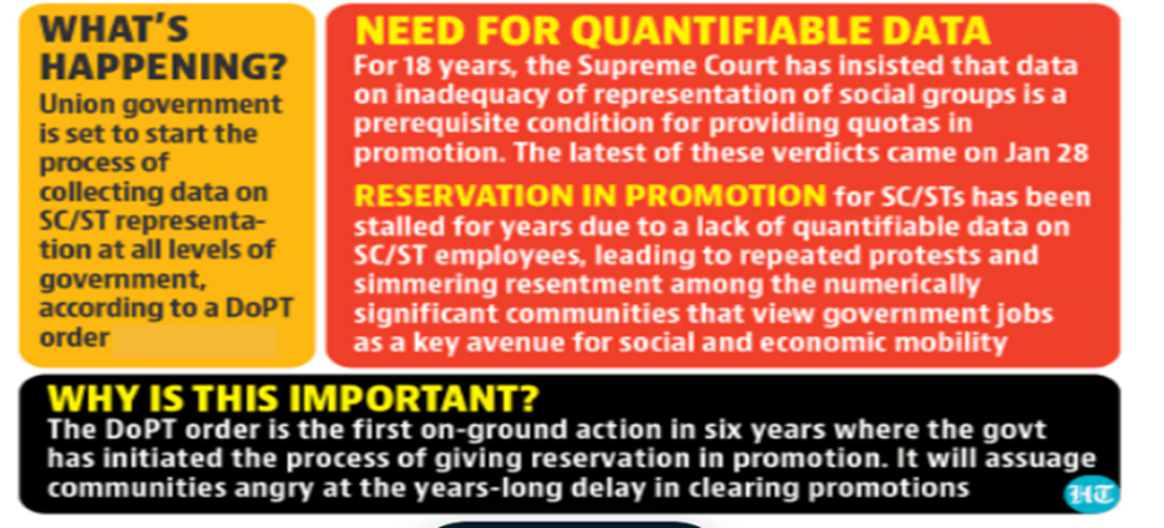
The SC Judgement
- The logjam in reservation in promotion dates to 2006, when a constitution bench ruling in the M Nagaraj case laid down three conditions:
-
- collect quantifiable data showing the backwardness of the group,
- its inadequacy of representation in a particular level of public employment
- ensuring administrative efficiency.
- After the judgment, some high courts struck down reservation in promotion policies by state governments.
-
- In 2018, another Constitution bench of the Supreme Court endorsed the stipulation of quantifiable data in the Jarnail Singh case.
- But the Centre and some state governments said that these conditions created administrative difficulties and stalled the promotions of thousands of employees, and requested the apex court to review its judgment.
- Overruling the Centre’s objection, the top court held on to its order to collect data for promotion.
- It emphasised that adequacy of representation cannot be gauged either on the basis of data on representation of SCs/STs with reference to entire service or in proportion of their population. But SC struck down the backwardness clause.
- Based on the SC’s ruling, the Attorney General has opined that three conditions are to be met while implementing the policy of reservation in promotions:
- Collection of quantifiable data regarding inadequacy of representation of Scheduled Castes and Scheduled Tribes;
- Application of this data to each cadre separately;
- If a roster exists, the unit for operation of the roster would be the cadre or which the quantifiable data would have to be collected and applied in regard to the filling up of the vacancies in the roster.
Sources:
- Centre sets ball rolling for quota in promotions:
- Government lays down norms for quota in promotions :
- Quota in Promotion: Centre Asks Depts to Collect Data on Inadequacy of Representation of SCs, STs:
- Reservation in promotion:
- Reservation in promotion:
- Reservation in Promotion: Court in Review:
- Reservation In Promotion: Plea In Supreme Court Seeks Review Of Declaration That M Nagaraj Judgment Will Have Only Prospective Effect:

Solid- state batteries - Edukemy Current Affairs
In News
Solid state batteries can be the alternative to the current lithium ion (Li-ion) batteries with liquid electrolytes.
About the News
- In recent times, a number of Electric vehicles powered by Li-ion batteries have erupted into flames.
- Although the electric vehicles story is taking off rather nicely in India however, issues like fire in EVs especially scooters can be the dampener to this heartening data is in the form of safety concerns.
- The government of India recently announced research in solid-state battery. This initiative of the Department of Science and Technology is one of three that constitute the ‘Integrated Clean Energy Material Acceleration Platform’.
- The research aims to accelerate the development of solid-state battery technology using AI [artificial intelligence] and ML [machine learning], through automated processes
What is the Mechanism through which EVs catch fire?
- Typically, in Li-ion batteries the liquid electrolytes are organic solvents, which are highly flammable. If current distribution is uneven, filament-like structures called dendrites can form, connecting the two electrodes and causing a short-circuit.
- The dendrites connect the anode and cathode through the separator, providing a low-resistance path for electron transport, resulting in high self-discharge currents to ignite the flammable electrolyte and leading to explosions.
How Will Solid state batteries solve the problem?
- Solid-state batteries have only solid components which have even distribution which are more stable and have an energy density of 350 watt-hour per kg, as opposed to 100-260 Whr/kg of the conventional lithium-ion batteries.
- The absence of a liquid electrolyte in all-solid-state lithium batteries simplifies the packaging and reduces dead weight in the battery, resulting in improved energy density.
- Solid-state electrolytes are typically less reactive than today’s liquid or gel-type electrolytes; they will last longer.
- Solid-state batteries combine the performance of conventional lithium-ion/lithium polymer systems with higher safety for usage and flexibility in form-factor, to target versatile applications.

Way forward
- The major challenges in solid state batteries arise out of the basic differences in the electrochemical, mechanical and electrical properties of the solid electrolytes, compared with the conventional liquid electrolytes.
- A big question is whether the existing infrastructure for lithium-ion battery production could be exploited for making solid-state batteries.
For reading the article on EVs catching fire, refer to: https://edukemy.com/current-affairs/gazette/2022-03-31/evs-catching-fire
Sources:
India’s Growth Forecast: World Bank
In News
The World Bank has slashed India's GDP forecast for fiscal year 2022-23 from earlier prediction of 8.7% to 8%.
About the News
- In its twice yearly report “South Asia Economic Focus Reshaping Norms: A New Way Forward” released recently, the World Bank has slashed India's GDP citing worsening supply bottlenecks and rising inflation risks caused by Russia's invasion of Ukraine.
- According to the report, impact of the war has been further inflation, deteriorating current account balances and growing fiscal deficits.
- Projected Growth: It projected India to grow at 8% over the current fiscal year (April 1- March 31), and 1% over the next (FY 2023-24).
- Household consumption: In India, household consumption will be constrained by the incomplete recovery of the labour market from Covid-19 and inflationary pressures.
- Skyrocketing oil and food prices: High oil and food prices caused by the war in Ukraine will have a strong negative impact on peoples’ real incomes.
- Growth prospects of South Asia Region: The report has cut by a full percentage point the growth outlook for South Asia, excluding Afghanistan, to 6.6%.
- It noted that the region's dependence on energy imports meant high crude prices forced its economies to pivot their monetary policies to focus on inflation rather than reviving economic growth after nearly two years of pandemic restrictions.
- Suggested Measures for Economic Revival:
- Careful Planning of Monetary & Fiscal Policies: Given these challenges, governments need to carefully plan monetary and fiscal policies to counter external shocks and protect the vulnerable, while simultaneously laying the foundation for green, resilient and inclusive growth.
- Effective resilience to global sanctions: The impact of sanctions on Russia on the South Asian region is more indirect than direct, given the relatively low proportion of imports and exports that go to and from Russia and Ukraine.
- The indirect impact was via the global impact of sanctions on commodity and financial markets.
- Thus the countries in this region have to formulate effective crisis resilient policies for slow yet steady recovery.
- Adopting Greener fuels: The report suggests that countries in the region should move towards greener fuels and commodities as a response to rising fuel prices and the introduction of green taxes. This would also be a new source of government revenue.
- Taxing fuel consumption: Green tax recommendation when applied to firms that are polluting, will be of greater significance as the money collected can be much better used when the right price for energy is being charged and then redistributed in a way that really targets the poor households.
Source:
- India projected to grow at 8% this fiscal: World Bank
- World Bank cuts India's GDP growth forecast to 8% from 8.7% in FY23
- India growth forecast cut to 8% for FY23, says World Bank
Image source:
Sinking of the Titanic
On April 15, 1912, the RMS Titanic sunk in the North Atlantic Ocean. The largest and most luxurious ship in the world, the Titanic was also one of the most technologically advanced. The ship had 16 watertight compartments designed to keep it afloat if damaged. This led to the belief that the ship was unsinkable. However, only four days into its maiden voyage, the Titanic struck an iceberg near Newfoundland, Canada. The collision damaged the ship and its watertight compartments. With a limited number of lifeboats, many passengers could not escape the ship. Only hours after the collision, the Titanic sunk, taking about 1,500 passengers with her. The fate of the Titanic led to new international agreements to prevent future disasters, such as the creation of an International Ice Patrol that would alert ships of icebergs. In addition, the first International Convention of Safety of Life at Sea created new lifeboat regulations to protect the safety of passengers.

Source:
The Hindi Language Debate
In News
The Centre’s stand on making Hindi a compulsory language for students up to Class 10th across the eight States in the northeast has been causing tensions among various organisations in the region.
About The News
- Union home minister, who chairs the Parliamentary Official Language committee, had announced that Hindi would be made compulsory in all eight northeastern states upto Class 10, calling it the “language of India”.
- It has been said that 2,200 Hindi teachers have been recruited in the Northeast to teach Hindi.
- Later it was clarified that Hindi should be an alternative to English and not local languages.
- Several Northeast-based organisations — including Assam’s apex literary body, the Asom Sahitya Sabha and Manipur’s Meitei Erol Eyek Loinashillon Apunba Lup (MEELAL), a group established to safeguard Manipuri manuscripts and language — have opposed the Centre’s proposal and urged the government to reconsider its move.
- In the Northeast region, Hindi is compulsorily taught till Class 8 except in Arunachal Pradesh, where the language is a mandatory subject till Class 10. In Tripura, Hindi is not compulsory at all in school.

- Many organisations have called it an imposition that may harm indigenous languages. They have argued that Hindi may be an optional language but not a compulsory subject.
The Hindi Debate - A background:
- The Constituent Assembly of India in 1949 debated the status of India’s languages.
- Among the issues that were discussed were the use of the term ‘national language’, instead of ‘official’ language; Hindi vs the other Indian languages; etc.
- The Munshi-Ayyangar formula was incorporated in the Constitution under Part XVII, Chapter I. It provided for Hindi as the Official Language of the Union government.
- However, the use of English for the first 15 years was allowed (with an option of a further extension) for a smooth transition.
- After the aforementioned 15 years came to a close, in 1965, the proposals to make Hindi the official language was met by protests in the southern states.
- In response, the then Prime Minister Jawaharlal Nehru gave an assurance that English would not be substituted by Hindi, until the non-Hindi speaking people desire a change.
- In 1963, the Official Languages Act was passed which authorised the continuance of English as an official language, in addition to Hindi.
- Therefore, both Hindi and English became official languages of India.
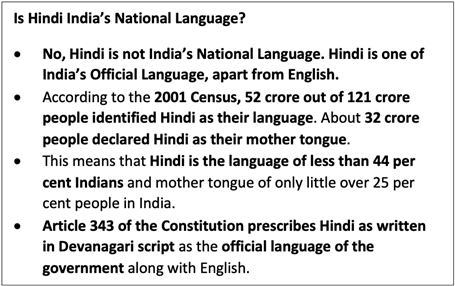
Language Classification in India
- Apart from English and Hindi as official languages, as per the provisions of Articles 346 and 347, the Legislature of a State may by law adopt any one or more of the languages in use in the State or Hindi as the language or languages to be used for all or any of the official purposes of that State.
- As per Articles 344(1) and 351 of the Indian Constitution, the Eighth schedule includes the recognition of the following 22 languages. The states may choose the languages mentioned in the Schedule as their official language.

Why does the demand or desire of Universal application of Hindi arise?
- It has been contended that Hindi language will unite the people of India, a land of multitudes of languages and a plethora of dialects of such.
- It has been suggested that, ‘One language’ will make the people of this vast country come closer to one another.
- Another contention has been regarding the opposition of English as an official language.
- With the colonial past of India, many a times the issue of anglicization of the masses has been raised. There have been demands to have an indigenous language rather than an imposed foreign language, as an official language.
- Governance troubles arise due to the diversity of languages in the country. With uniformity of language across regions, it will become easier for the administration to function well.
- Moreover, it is understood that the Hindi language accounts for approximately 40-43 per cent of native speakers in India. Hence, it becomes a natural choice for being chosen as the language of India.
What would be the impact of making Hindi compulsory in Non-Hindi Speaking states?
- If Hindi is imposed on the non-speakers, it will make it necessary for them to learn the language. In effect, members of northern India, where a majority of native-Hindi speakers reside, would be placed at an advantage over the others.
- Any imposition of a universal language would lead to massive governance restructuring that may lead to years of policy and governance issues.
- Non-speakers may harbour a feeling of discontent and may revolt against such a decision, as has happened in the past. Such a move may cause distress to the diversity of a country like India.
- Also, several non-speakers may choose not to learn Hindi and may be at the danger of being pushed away from the mainstream. Especially, vulnerable population like tribals, disadvantaged, Scheduled Castes and women would face the brunt of such an imposition.
- It would take years to get such vulnerable section of non-Hindi-speaking regions to learn the language, which would imply, as many years of deprivation of opportunities for such a population.
- Forceful encouragement of one language over other native languages may lead to degeneration and extinction of other regional languages.
Way Forward
- The three-language formula: Originally devised in 1968, the three-language formula stipulated that student from the Hindi-speaking states should take up English, Hindi and a modern Indian language, while students from non-Hindi speaking states should also take up Hindi, English and one Indian language.
- The formula was implemented across the country in 1968, barring Tamil Nadu that adopted a two-language policy.
- But this formula was opposed by the Southern states calling it an imposition of Hindi and was hence amended in 1992.
- Recently, the New Education Policy resurrected the formula, only to be retracted after a furore over the issue.
- It is important to keep the sentiments of regional language speakers in mind while promoting Hindi language.
- Any policy that may harm the local indigenous language and cause distress to its speakers should be framed with caution.
Conclusion:
Languages are a wealth, which have been created through years of churning. They need to be preserved. Hindi may be encouraged so that it becomes a standardised link language. But such an effort should not be pushed so far as to offend the sensibilities of other people of India who speak their languages and are equally proud of them. The Constitution of India balances with a sense of sensitivity and equality amongst the people to give due respect to ethnic identity of the peoples, their language and their culture. The Constitution of India speaks of a composite culture of the nation.
Question: Discuss the reasons why Hindi need not be made a compulsory language to be learnt in all states of India.
Sources:
- Northeast opposes Hindi as compulsory school subject:
- Northeast groups oppose Centre’s Hindi move, call it an ‘imposition’:
- N-E opposes plans to make Hindi 'must' school subject:
- Move to make Hindi compulsory in North East schools will create disharmony: Students' bodies:
- Instead of making Hindi compulsory, focus on upliftment of indigenous languages: Students’ Bodies:
- Move to make Hindi compulsory in NE will create disharmony: Students' body:
- India is a nation without a national language. Let’s embrace this:
- Explained: 70 years ago, here’s how the Constituent Assembly debated status of Hindi:
- Debate: Hindi Is Already the National Language of India:
- Hindi As National Language Of India : Decoding The Myth:
- JAYAKANT MISHRA Vs. STATE OF BIHAR:
- Use of Hindi Language in Courts:
- All about 3-language formula, the bone of contention between Centre & southern states:
- Language Problem in India – Responses of the constitution and law:
- Despite What Popular Belief May Suggest, Hindi Is Not India's National Language:
- Hindi as our national language: Myth and reality:
Baby Dragon
This is image of strange-looking sea creature that looks like a 'baby dragon'. A Russian fisherman has reeled in a creature from the depths of the ocean which looks like a 'baby dragon'. The fish has massive eyes, and a long tail, and appears to be light pink in colour. It also has what appear to be wings on its side. It is a chimaera, a cartilaginous fish also known as a 'ghost shark'. Each family of chimaera fish has a distinctive, somewhat gruesome appearance, and they are often collectively referred to as “ghost sharks” because of their strange, pale coloring.

Source:
Duty-free import of raw cotton
- Context:The finance Ministry has waived the customs duty on cotton imports till September 2022.
- Currently,cotton imports attract 5% Basic Customs Duty (BCD) and 5% Agriculture Infrastructure Development Cess (AIDC).
- Thus the waiver of duty willbenefit the textile industry and keep domestic prices low for consumers.
- It would alsopromote exports of value added products such as apparel and made-ups sectors significantly by softening the prices of yarn and fabrics.
- Cotton textile exports will get a further boost as the high prices of cotton were blunting the competitive edge
- As India had increased its market share in apparel exports tothe U.S. and many other countries recently and having signed the free trade pact with the UAE and Australia, this move is expected to further accelerate the trend.
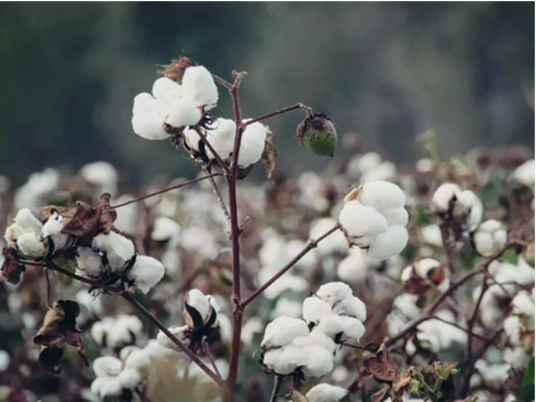
Source:
- Duty-free import of raw cotton to push exports of value-added textiles: FIEO
- Import duty removal on cotton may help bring down prices: Textile Secretary
Image source:
HAL ties with IAI
- Context: Hindustan Aeronautics Limited (HAL) and Israel Aerospace Industries (IAI) have recently entered into a MoU to convert civil passenger aircraft to Multi Mission Tanker Transport (MMTT) aircraft in India.
- Under the pact HAL will convert pre-owned civil (passenger) aircraft into air refuelling aircraft with cargo and transport capabilities.
- The aircraft likely to be converted is a Boeing 767 passenger jet.
- Mid-air refuelling significantly enhances the range and payload of fighter jets.
- It also allows the aircraft to stay in the air much beyond their normal limits allowing better exploitation of the platforms capabilities.
- The MoU will facilitate HAL and IAI's decades' long expertise in developing, manufacturing and producing leading defence platforms.
- It will also provide India’s defence ecosystem with new capabilities and cost effective solutions in the market.

Source:
- HAL ties up with IAI of Israel to convert passenger aircraft into mid-air refuellers
- HAL ties up with Israel Aerospace Industries to convert civil aircraft to multi mission tanker transport Aircraft
Image source:
Yakshagana - Edukemy Current Affairs
- Context: Students from outside Karnataka have been approaching the kalakendra to learn Yakshagana since 1992.
- Yakshagana is a traditional theatre form that combines dance, music, dialogue, costume, make-up, and stage techniques with a unique style and form.
- It literally means the song (gana) of the yaksha (nature spirits).
- It has its origin in Udupi, in the state of Karnataka and is also popular in other districts of Dakshina Kannada, Kasaragod, Udupi, Uttara Kannada and Shimoga .
- This folk art is believed to have originated between the 10th and 16th century and is
strongly influenced by the Vaishnava Bhakti movement. - Its stories are mainly drawn from Ramayana, Mahabharata, Bhagavata and other Hindu epics.
- A typical Yakshagana performance consists of background music played by a group of musicians (known as the himmela); and a dance and dialog group (known as the mummela), who together enact poetic epics on stage and is traditionally presented from dusk to dawn.
- It can be classified as:
- The tenkutittu style:that is prevalent in Dakshina Kannada which involves high flying dance moves; and its extravagant rakshasas (demons) and
- The Badagutittu style:which is prevalent in Uttara Kannada District that plays more emphasis on facial expressions, dialogues and dances appropriate for the character depicted in the episode.
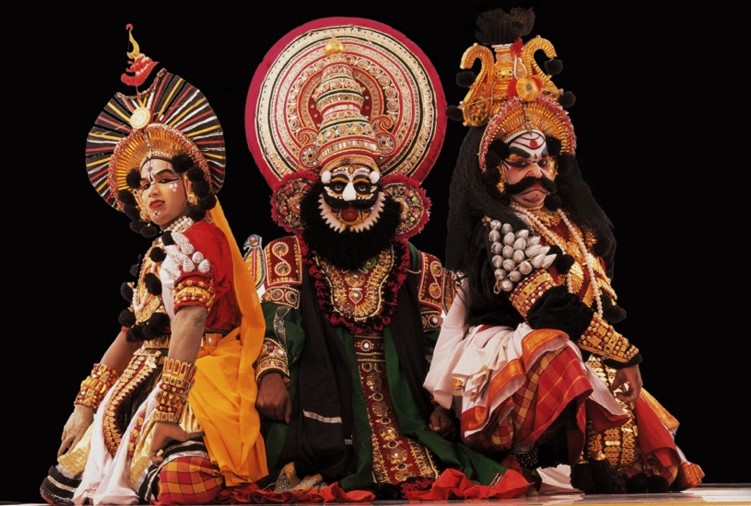
Source:
Image source:
Centibillionaire’s Club
- Context: According to the Bloomberg Billionaires Index, Gautam Adani’s net worth has recently reached $100 billion making him the only Indian member of the centibillionaire’s club.
- The club refers to people whose net wealth is $100 billion or above.
- Although Bill Gates had a net worth of over $100 billion in 1999 for a brief period, the term centibillionaire did not gain currency until Jeff Bezos, the founder of Amazon, increased his wealth to $112 billion in 2017.
- It is since then that he was referred to as the world’s first centibillionaire.
- By 2020, with Mark Zuckerberg joining the group, the number had increased to five with other four members being Tesla’s Elon Musk, Bill Gates, Bezos and Bernard Arnault, the chairman and CEO of Louis Vuitton
- Today, the club has 10 members, with Musk on top followed by Bezos
- Adani is tenth on the list and $3 billion below the person above him Oracle’s Larry Ellison-whose net wealth is $103 billion.
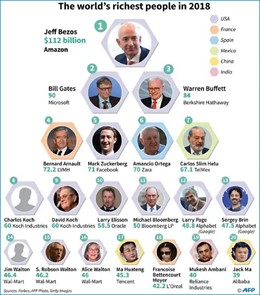
Source:
- Explained: What is the centibillionaire’s club which Gautam Adani became the newest member of?
- Adani Joins $100 Billion Club, Adds Highest Wealth Amongst Ambani, Bezos, Musk & Others This Year
Image source:
Hate speech is violent in itself and must be called out: Indian Express
Essence: As per the author, hate speech is at the root of many forms of violence and is one of the biggest challenges to the rule of law. Hate speech along communal lines for electoral dividends is increasing in electoral mobilisation. The law is not taking its course in the hate speech incidents as in 2019, the Supreme Court called Election Commission “toothless” for not taking action against candidates engaging in hate speech.
Sections 153A, 295A and 298 of IPC criminalises the promotion of enmity between different groups of people on grounds of religion and language. Section 125 of the Representation of People Act, 1951 punishes promoting feelings of enmity and hatred on grounds of religion and caste during election campaigns. Section 505 of IPC criminalises multiple kinds of speech.
As per the author, the lack of political will, inefficiency and bias of the administration, apathy of the judiciary and presence of hate speech in the media that is leading to hate speech. Thus, all need to call out the hate speech and the law must take its course.
Why should you read this article?
- To know about the incidents of hate speech, as per author, usage in the election mobilisation.
- To know about the legal remedies available in the fight against hate speech.
- To know about the authors views on why the hate speech is not curtailed.
Source:
Data divide between state, citizens is bad for democracy: Indian Express
Essence: The editorial highlights the issue of government generating, consuming, and safeguarding public data and not sharing it with public. Enormous data gets generated with the JAM (aadhar, bank account, mobile) trinity, surveys on industry, consumption, family, and health survey, etc. Data was consumed by the government during covid lockdown on movement of migrant workers, immunization, and health status of people, all kept by the government in the name of running welfare programs and targeting of beneficiaries.
However, data regarding covid deaths was suppressed, annual survey of industries has been replaced by internal data from govt on policy making, sanitation and open defecation data wasn’t shared on time and many such employment linked surveys not brought out in the open.
Data can work wonders if shared with masses and private stakeholders- improve public discourse, increase accountability and transparency, steer effectiveness of state policies and guide private participation, mapping resources/demand/consumption, etc. More information should be collected and shared about poverty and deprivation to help the growth of society and decrease the gap in accountability. Not limiting the availability of data can foster the smooth functioning of Indian democracy.
Why should you read this article?
- To know the potential of sharing data with the public and ways to decrease the data gap.
- To understand the shortcomings in data governance.
Source:
India needs an economic reboot for rapid employment- heavy growth: Live mint
Essence: The editorial stresses on the fact that India needs both- greater output and more employment. A large proportion of the unemployed labor force in India is the youth population, and to be able to provide them employment before the demographic dividend runs out, India needs to accelerate its growth rate in the present decade. But due to slowdown in manufacturing in last decade followed by massive covid shocks, and now the Russia-Ukraine war, numerous micro and small enterprises have died. The growth elasticity of employment- growth in employment relative to growth in gross domestic product has only been declining in the country.
India needs a structural transformation in the mid and long-term trajectory. Presently, 90% Indian work force gets employed in low/unskilled jobs. Unemployment rate is as high as 35-40% amongst graduates. Providing skills and employability according to global norms is the need. In the mid term, low skilled work force could be absorbed by industry sector in construction and service sector in trade/hotels/transportation. In the long run, providing large-scale expansion of skilled jobs, with forward and backward links would steer Indian work force towards growth.
Why should you read this article?
- To know the extant of joblessness in Indian youth and its reasons.
- To understand about the possible sectors which could provide employment in mid and long run.
Source:
Bank Sakhi
Background
- In rural India, finance for women is still restricted to self-help groups, many of which have disbanded over the years due to negligence and a lack of substantial efforts to engage women in microfinance.
- To remedy that and engage women in finance, neobank BharatATM launched a programme in March, called ‘Bank Sakhi’ (sakhi means female friend).
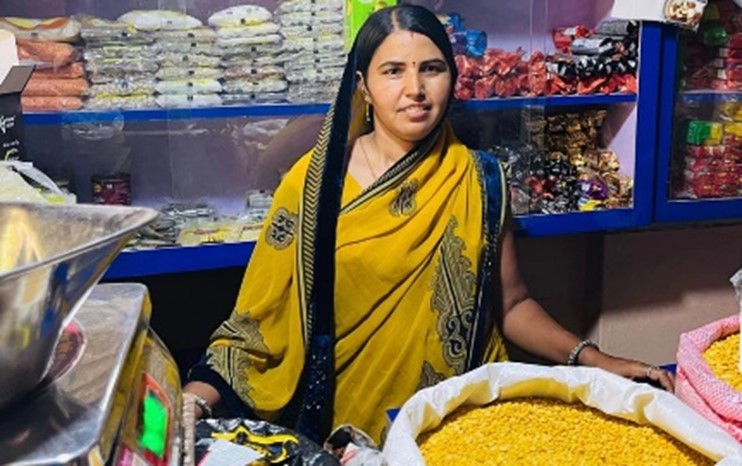
About Bank Sakhi
- BharatATM, launched in 2020, is a financial platform that enables kiranas and neighbourhood retail businesses to provide banking services to their consumers.
- The start-up’s new 'bank sakhi' project, which aims to 'financially empower women,' has already assisted 11,230 women in earning an average of Rs 8K per month.
- It essentially identifies women in small towns and villages, partner with them and onboard them on the BharatATM platform so they can start offering its services, such as withdrawal/deposits, bill payments etc, from either their kirana stores, if they have one, or at people’s doorsteps.
- Across India, the company has enrolled over 11,230 women in the programme. The idea was piloted in Odisha, with roughly 230 women engaged in the programme.
Quote: “Give a man a fish, you feed him for a day; teach a man to fish, you feed him for a lifetime".
Source:
Share the article
Get Latest Updates on Offers, Event dates, and free Mentorship sessions.

Get in touch with our Expert Academic Counsellors 👋
FAQs
UPSC Daily Current Affairs focuses on learning current events on a daily basis. An aspirant needs to study regular and updated information about current events, news, and relevant topics that are important for UPSC aspirants. It covers national and international affairs, government policies, socio-economic issues, science and technology advancements, and more.
UPSC Daily Current Affairs provides aspirants with a concise and comprehensive overview of the latest happenings and developments across various fields. It helps aspirants stay updated with current affairs and provides them with valuable insights and analysis, which are essential for answering questions in the UPSC examinations. It enhances their knowledge, analytical skills, and ability to connect current affairs with the UPSC syllabus.
UPSC Daily Current Affairs covers a wide range of topics, including politics, economics, science and technology, environment, social issues, governance, international relations, and more. It offers news summaries, in-depth analyses, editorials, opinion pieces, and relevant study materials. It also provides practice questions and quizzes to help aspirants test their understanding of current affairs.
Edukemy's UPSC Daily Current Affairs can be accessed through:
- UPSC Daily Current Affairs can be accessed through Current Affairs tab at the top of the Main Page of Edukemy.
- Edukemy Mobile app: The Daily Current Affairs can also be access through Edukemy Mobile App.
- Social media: Follow Edukemy’s official social media accounts or pages that provide UPSC Daily Current Affairs updates, including Facebook, Twitter, or Telegram channels.

